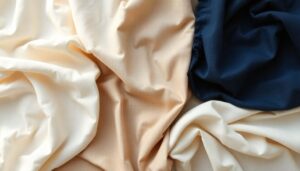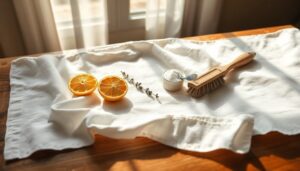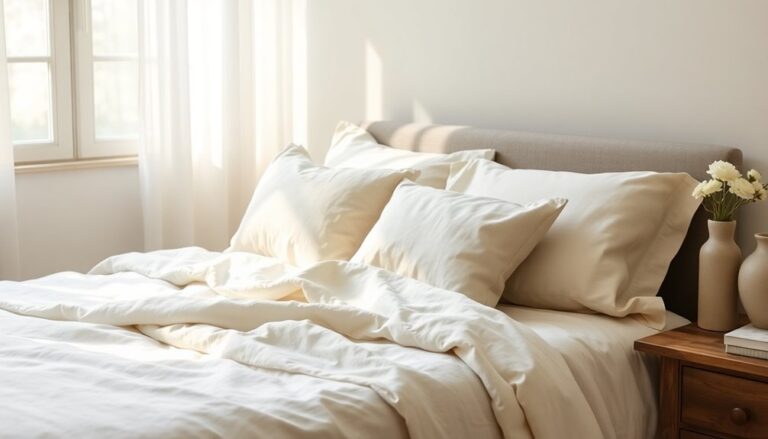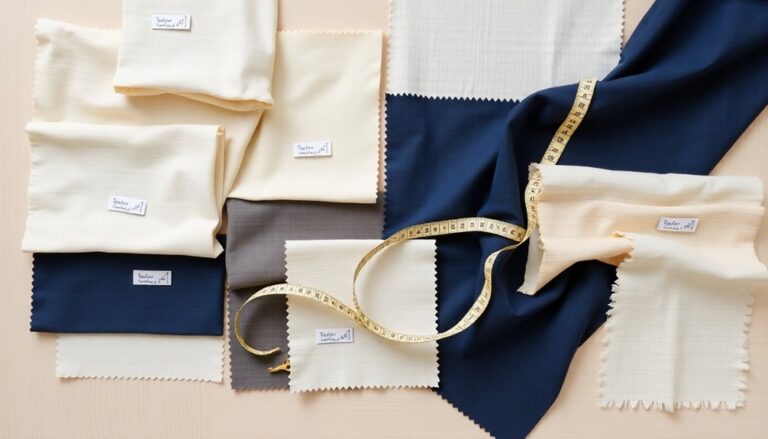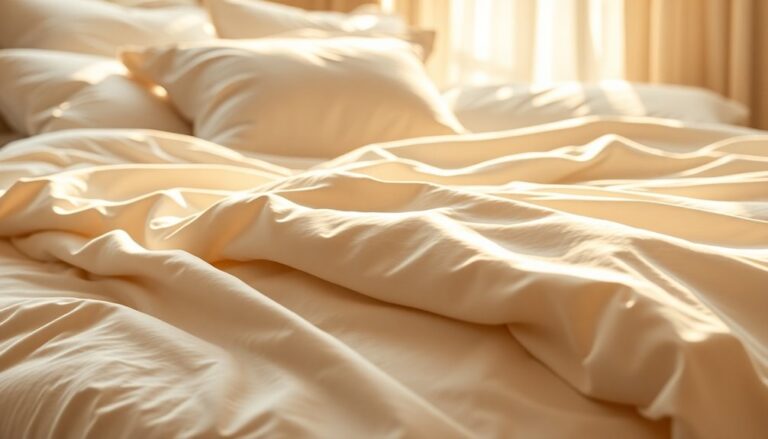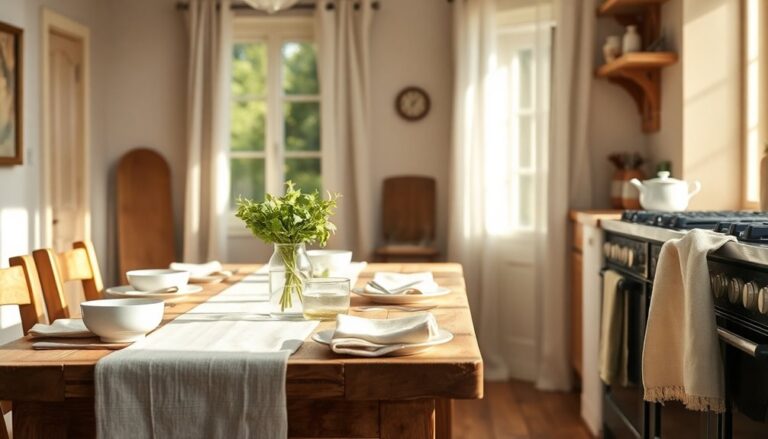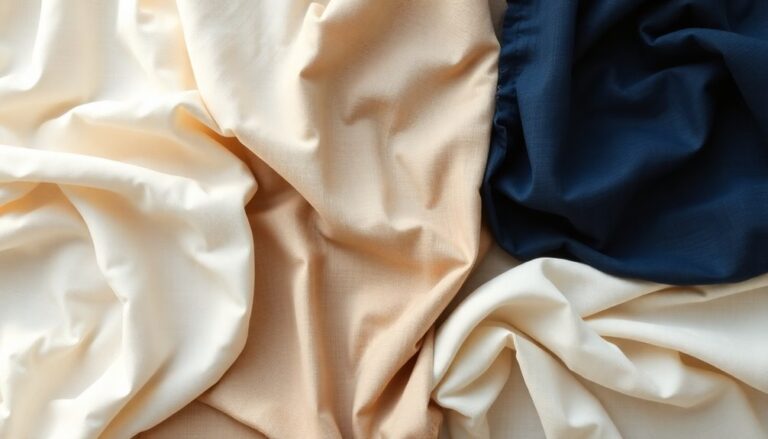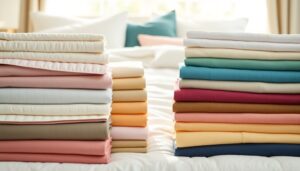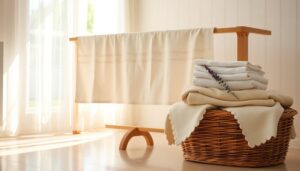Linen fabric offers notable benefits, including breathability, durability, and eco-friendliness, making it ideal for clothing and home textiles. Nevertheless, it can easily wrinkle and tends to have a higher initial cost. Its hypoallergenic properties and moisture-wicking abilities improve comfort, but care and maintenance require finesse to preserve its quality. Although linen's charm is timeless, its challenges shouldn't be overlooked. There's much more to explore about this fascinating fabric and its uses in both fashion and home decor.
Article Highlights
- Pros: Linen is highly breathable and comfortable, making it ideal for warm weather clothing and home textiles.
- Pros: Linen is durable and long-lasting, often outlasting other fabrics like cotton and polyester with proper care.
- Pros: Eco-friendly attributes include low water usage and biodegradability, appealing to environmentally conscious consumers.
- Cons: Linen tends to wrinkle easily, requiring careful storage and maintenance to preserve its appearance.
- Cons: The initial cost of linen can be higher than other fabrics, though it may save money over time due to durability.
The History of Linen

Linen has a rich history that dates back thousands of years, making it one of the oldest fabrics known to mankind. Its origins trace back to ancient civilizations, particularly in Egypt, where it was prized for its durability and breathability. Ancient uses of linen included clothing for the elite, burial shrouds, and even writing materials. The Egyptians cultivated flax, the plant from which linen is made, and their techniques set a standard for quality that's still appreciated today. Across various cultures, linen became synonymous with purity and wealth. Its versatility allowed it to be used in household items and textiles, establishing linen as a staple in both practical and ceremonial contexts throughout history.
Benefits of Linen Fabric
Linen fabric offers several benefits that make it a popular choice for many. Its breathability and comfort keep wearers cool, whereas its durability guarantees it withstands the test of time. Furthermore, linen is made from eco-friendly materials, making it a sustainable option for conscious consumers.
Breathability and Comfort
While many fabrics claim to offer comfort, few can match the breathability of linen. This natural fiber excels in allowing air to circulate, making it an ideal choice for warm weather. Its unique structure absorbs moisture, wicking sweat away from the skin and improving comfort levels. Unlike synthetic materials, linen doesn't cling to the body, providing a relaxed fit that promotes ease of movement. Those who wear linen often appreciate its soft, cool touch, which feels invigorating even on hot days. Moreover, linen's breathability contributes to its hypoallergenic properties, making it suitable for sensitive skin. Overall, choosing linen means opting for a breathable fabric that not only improves comfort but also raises the overall wearing experience.
Durability and Longevity
With regard to fabric choices, the durability and longevity of linen stand out markedly. When compared to other fabrics, linen boasts impressive fabric resilience, making it a preferred choice for those seeking long-lasting materials. Its natural fibers contribute to a lifespan comparison that often favors linen over cotton and synthetic alternatives.
- Linen can withstand repeated washings without losing integrity.
- Its strength increases when wet, enhancing durability.
- Linen resists fraying, fading, and other signs of wear.
- Proper care can lead to decades of use.
This remarkable durability not only assures users of its value but likewise makes linen a smart investment for various applications, from clothing to home textiles.
Eco-Friendly Materials
Choosing linen not only guarantees durability but additionally supports eco-friendly practices. Linen comes from the flax plant, which requires fewer pesticides and fertilizers compared to other crops, making it a prime example of sustainable sourcing. The cultivation of flax is likewise low in water consumption, further reducing its environmental impact. One of the standout benefits of linen is its biodegradable properties; when the fabric reaches the end of its life cycle, it decomposes naturally, returning nutrients to the soil. This makes linen a responsible choice for environmentally conscious consumers. By opting for linen, individuals can enjoy high-quality textiles while actively contributing to a more sustainable future, showcasing that style and eco-friendliness can go hand in hand.
Breathability and Comfort
Linen is often praised for its exceptional breathability and comfort, making it a popular choice for warm weather. This breathable fabric allows air to circulate freely, helping to regulate body temperature and wick away moisture. As a result, individuals often experience significant comfort benefits during the time they are wearing linen, especially during hotter months.
- Keeps the body cool by promoting airflow
- Absorbs moisture without feeling damp
- Softens with each wash, enhancing comfort
- Naturally resistant to allergens, promoting a healthy environment
These features make linen an excellent option for those seeking both style and functionality. Whether for clothing or home textiles, its breathability guarantees a pleasant experience, even in the sweltering heat.
Eco-Friendly Attributes
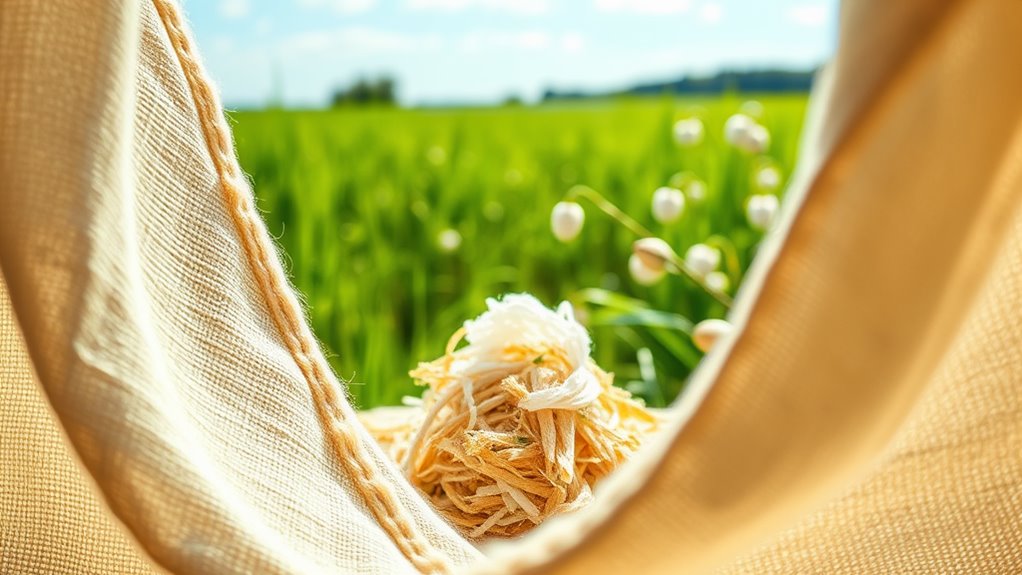
The comfort that linen provides is matched by its eco-friendly attributes, making it a sustainable choice for environmentally conscious consumers. Derived from the flax plant, linen production often involves sustainable practices that require less water and pesticides compared to other textiles. This contributes to a lower environmental impact during cultivation. Furthermore, linen's biodegradable properties guarantee that it won't linger in landfills for years, breaking down naturally over time. This natural decomposition process aligns with the growing demand for eco-friendly materials in various industries. By choosing linen, individuals support a textile that not just feels good but additionally promotes environmental health, making it an ideal option for those seeking to make responsible choices in their lifestyle and consumption habits.
Durability and Longevity
Even though many fabrics wear out quickly, linen stands out for its remarkable durability and longevity. This natural fiber is known for its impressive resistance factors, making it a practical choice for various applications. When considering lifespan comparison, linen often surpasses other common materials like cotton and polyester.
Key points about linen's durability include:
- Natural strength: Linen fibers are thicker and stronger than many alternatives.
- Resistance to wear: It withstands frequent washing and use without losing integrity.
- Mold and mildew resistance: Linen's moisture-wicking properties help prevent damp-related issues.
- Aging gracefully: Over time, linen develops a soft patina, enhancing its character without compromising quality.
Aesthetic Appeal

Linen's natural texture offers a unique versatility that improves various decor styles, from rustic to modern. Its timeless elegance adds a sophisticated touch to any setting, making it a favored choice for both casual and formal occasions. Furthermore, linen's exceptional color retention guarantees that its beauty lasts, maintaining its appeal through countless washes.
Natural Texture Versatility
Textured elegance defines linen's aesthetic appeal, making it a favorite choice in both fashion and home decor. Its natural texture versatility offers a unique charm that improves any setting. The linen texture benefits include its ability to complement various styles, from rustic to modern, as it provides a soft, breathable feel.
- Pairs well with bold prints and colors
- Easily shifts from casual to formal settings
- Adapts to seasonal changes effortlessly
- Improves tactile experience in both clothing and interiors
This design versatility allows creators to experiment, ensuring linen remains a timeless staple. Whether draped over furniture or worn as clothing, linen consistently delivers an aesthetic that's both sophisticated and inviting.
Timeless Elegance Factor
The allure of linen extends beyond its versatility, embracing a timeless elegance that improves any environment. Its natural texture and breathable qualities create a sophisticated ambiance, making it a popular choice for both casual and formal occasions. Linen's classic appeal adds depth and character to interiors, seamlessly blending with various design styles.
| Aspect | Linen |
|---|---|
| Timeless Style | Works in any decor theme |
| Versatile Applications | Home, fashion, and events |
| Seasonal Adaptability | Comfortable year-round |
Linen's ability to maintain its aesthetic charm over time allows it to remain relevant, embodying a style that transcends trends. This enduring quality makes linen a cherished fabric for those who appreciate elegance in simplicity.
Color Retention Quality
Even though many fabrics fade over time, linen stands out for its impressive color retention quality, guaranteeing that its vivid hues remain intact even after repeated washing and exposure to sunlight. This remarkable dye stability makes linen a popular choice for both clothing and home textiles. Unlike other materials susceptible to color fading, linen maintains its aesthetic appeal over the years.
- High resistance to color fading
- Durable dyes guarantee long-lasting vibrancy
- Retains beauty through multiple washes
- Ideal for both casual and formal settings
Ultimately, linen's ability to hold onto its colors contributes to its charm, making it a preferred fabric for those who value both style and longevity in their textiles.
Care and Maintenance
Caring for linen requires a bit of attention, but the effort pays off in durability and appearance. To keep linen looking its best, proper washing techniques are essential. It's recommended to wash linen in cold or lukewarm water, using a gentle cycle to prevent damage. For stain removal, treating spots swiftly with a mild detergent can help maintain the fabric's integrity. Avoid bleach, as it can weaken the fibers over time. Air drying is preferred, but if using a dryer, a low heat setting is advisable. Regularly rotating linen items can likewise extend their lifespan. With these care tips, linen enthusiasts can enjoy their beautiful, long-lasting fabric for years to come.
Wrinkling and Creasing
Although linen is celebrated for its breathability and natural texture, it is likewise notorious for wrinkling and creasing easily. This characteristic can be a drawback for those who prefer a polished look. Nevertheless, various wrinkle prevention techniques and creasing solutions can help manage this issue effectively.
- Choose finely woven linen for less wrinkling.
- Store linen items flat or rolled to prevent creases.
- Use steam or a damp cloth when ironing for better results.
- Opt for a linen blend, which may reduce wrinkling.
Whilst the natural look of linen can be charming, comprehending these strategies can help maintain a more refined appearance. Embracing these methods allows one to enjoy linen's benefits whilst managing its tendency to wrinkle.
Cost Considerations
When considering linen, the initial investment price can be a significant factor for many consumers. Nevertheless, it's important to weigh this against the long-term value analysis, as linen's durability may lead to cost savings over time. Comprehending these cost considerations can help buyers make informed decisions about their purchases.
Initial Investment Price
Linen, known for its durability and breathability, often comes with a higher initial investment compared to other fabrics. When considering the initial costs, potential buyers should conduct a price comparison to grasp the value they're getting. Although linen may seem pricey upfront, its unique qualities can justify the expense.
- Higher quality fibers contribute to durability
- Maintenance costs may be lower in the long run
- Versatile for various uses, from clothing to home textiles
- Eco-friendly production methods can appeal to conscious consumers
Ultimately, comprehending the initial investment can help individuals make informed decisions about incorporating linen into their lives, even though it means spending more initially.
Long-term Value Analysis
Though some may hesitate at the initial cost of linen, a long-term value analysis reveals it can be a wise investment. Linen's durability and natural fibers contribute to its longevity, often outlasting less expensive fabrics. This durability means fewer replacements over time, making it a solid long-term investment. Furthermore, linen tends to retain a higher resale value compared to synthetic alternatives. As it ages, linen often becomes softer and more desirable, appealing to buyers who appreciate its unique texture and quality. Therefore, even though the upfront cost may be intimidating, the potential for lasting use and resale value makes linen a financially sound choice for those looking to invest in quality textiles.
Uses of Linen in Fashion and Home Decor
Linen's versatility makes it a popular choice in both fashion and home decor. Its breathable nature and natural texture align well with current fashion trends, making it a staple in summer wardrobes. Designers often incorporate linen into garments like dresses, shirts, and trousers, reflecting a casual yet chic vibe. In home aesthetics, linen's elegance adds a touch of sophistication to various spaces.
- Tablecloths and napkins for dining elegance
- Curtains that filter light beautifully
- Cushions and throws for a cozy feel
- Bedding that promotes comfort and relaxation
Frequently Asked Questions
Can Linen Be Blended With Other Fabrics?
Linen can definitely be blended with other fabrics, creating unique fabric combinations that improve both texture and durability. Designers often utilize various blending techniques to achieve desired qualities, such as softness or stretch. For instance, combining linen with cotton can result in a breathable, lightweight material, whereas mixing it with synthetic fibers can enhance wrinkle resistance. These blends not just offer practical benefits but additionally add visual interest to clothing and home textiles. However, it is essential to consider linen blend pros and cons when selecting the right fabric for specific needs. While blends can enhance comfort and longevity, some combinations may reduce the natural breathability of linen or require special care. Understanding these trade-offs helps in making informed choices for both fashion and home decor applications.
How Does Linen Compare to Cotton in Softness?
When considering the linen texture comparison to cotton softness, one can find notable differences. Linen's texture tends to be more textured and slightly rougher, whereas cotton is typically softer and smoother against the skin. Nonetheless, linen's breathability and moisture-wicking properties make it a popular choice for warm climates. In the end, it's about personal preference; some might appreciate linen's unique feel, whereas others may prefer the classic softness of cotton for everyday wear.
Is Linen Suitable for Sensitive Skin?
They say, "A stitch in time saves nine," and this holds true for sensitive skin. Linen's benefits are numerous; it's breathable and moisture-wicking, which helps prevent irritation. Unlike some fabrics, linen's natural fibers don't trap heat, making it less likely to cause discomfort. Nevertheless, some individuals might still experience linen irritation because of allergies or sensitivities. Overall, linen's qualities make it a favorable choice for those needing gentle, soothing fabrics.
What Are Common Uses of Linen in Industries?
Linen's versatility makes it a popular choice in various industries. In home textiles, it's often used for bed linens, tablecloths, and curtains because of its breathability and durability. The fashion industry likewise embraces linen, crafting clothing that's both stylish and comfortable, especially in warmer months. Its natural texture adds an elegant touch, appealing to eco-conscious consumers. Overall, linen's applications highlight its enduring appeal across different sectors.
How Does Linen Perform in Hot Weather?
In terms of hot weather, linen's breathability benefits are significant. It allows air to circulate, keeping the body cooler compared to other fabrics. Additionally, linen's moisture absorption capabilities mean it can soak up sweat without feeling damp or heavy. This combination makes linen an ideal choice for summer clothing. People often find that wearing linen helps them stay comfortable and dry, even during the hottest days.



